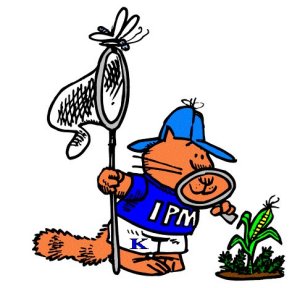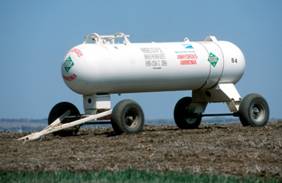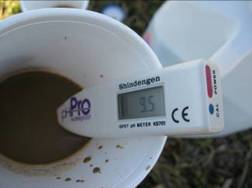Corn & Soybean News
April 2009, Volume 9, Issue 4
Corn and Soy Newsletter Home
Grain Crops Extension Home
Cooperating Departments: Agricultural Economics, Biosystems and Agricultural Engineering,
Entomology, Plant Pathology , and Plant and Soil Sciences
Editor: Chad Lee
In this issue
1. Corn Planting Dates and Yields
2. Avoiding Sidewall Compaction
3. Avoiding Anhydrous Ammonia Injury to Corn
4. Other Soil Fertility Concerns: N, P and K
5. Insect Risks in Late-Planted Corn
6. Disease Risks in Late-Planted Corn
7. Corn Grows Faster When Planted Later
8. A Quick Word About Soybeans
9. Going Paperless
printer-friendly pdf (Note: this html site is also printer-friendly)
1. Corn Planting Date Effect on Yields
Jim Herbek and Chad Lee, Extension Agronomists
Plant and Soil Sciences, University of Kentucky
Wet weather since late March has delayed corn planting. According to the National Agricultural Statistics Service, only 20% of intended corn acreage was planted in Kentucky as of April 26 compared to the 5-year average of 57%. If recent weather forecasts hold true, corn planting will continue to be hindered through early May.
So, when can we expect to lose yield on corn based on planting date? Research indicates that corn should be planted by early- to mid-May to avoid yield losses. In west Kentucky, corn should be planted by May 1-5, according to six years of research at that the UKREC in Princeton, KY Extrapolating these results to other areas of the state: corn planting should be completed by May 1 in extreme western Kentucky; by May 5-10 in west-central Kentucky; and by May 10-15 in eastern Kentucky to achieve maximum yield potential. There is an average yield loss of 1 to 2 percent per day for corn planted after early May (west Kentucky) to mid-May (eastern Kentucky).
Most of you reading this and looking at weather forecasts know that you will not get all of your corn in the ground before these dates. Don't panic. There is more to this story.
The corn yield penalty for delayed planting is not constant and can be quite variable from year to year (Figs. 1 and 2). While our research indicates yields losses for corn planted sometime after the first or second week of May, statewide average yields tell a slightly different story. If at least 80% of the corn crop is planted by the third week of May, then we still have a chance for good yields (Fig. 1). The trend for corn yields to be lower as planting is delayed across the state has a very low correlation (R2 = 0.3). The statewide averages indicate that more than just planting date goes into making good yields. Actual planting date and yield data from a central Kentucky farming operation would imply that the optimum window for planting is around the first or second week of May (Fig. 2). As you can see, there is a lot of variability is this data as well, indicating that more than just planting date determines yield.
Figure 1. Statewide average corn yield relative to the percentage of acres planted by the third week of May (source: National Agricultural Statistics Service).
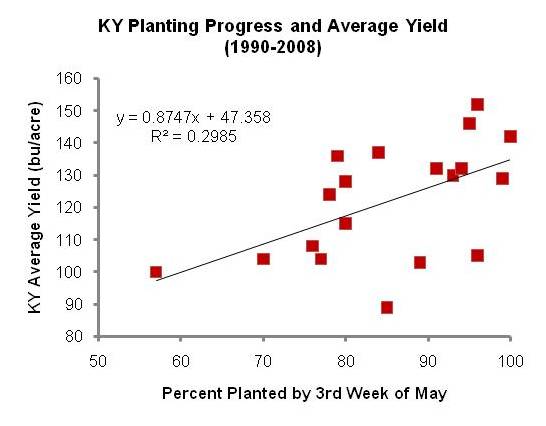
Figure 2. Planting dates and yields for each field in a central Kentucky farming operation from 2003 through 2007, regardless of hybrids, soil types, field size or seeding rates. 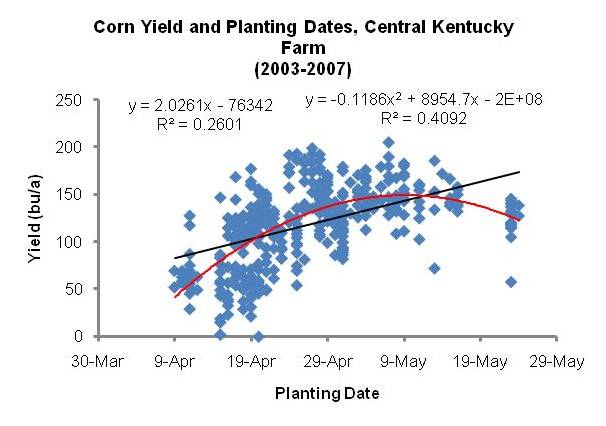
Some of the other factors that affect corn yield include timely rainfall, adequate heat units, low stress at pollination, adequate nutrients, etc. So, if the rest of 2009 turns out to have favorable weather, we would expect any potential yields losses from late planting to be much less than predicted. Of course, if 2009 turns dry like 2008, well… let's just hope it doesn't.
Some things to consider when planting corn in May
Use a corn hybrid with the Bt trait for corn borer. University of Kentucky research shows a yield benefit and an economic benefit to Bt corn borer hybrids planted in May. The later the planting date, the greater the yield benefit for the Bt hybrid.
Possibly switch to an earlier-maturing hybrid. Based on calculations of growing degree days remaining in an average season, hybrids with relative maturities of 118-day (and less) will reach physiological maturity (black layer) before frost in west Kentucky even if planting is delayed until late May. For late May plantings in central and eastern Kentucky, hybrids of 116-day relative maturity or less are likely needed. If planting occurs in early to mid-June, then a switch to hybrids of 113 to 116-day relative maturities will likely be needed. For extremely late plantings (after mid-June), hybrids of 110 to 113-day relative maturities or less are needed.
Keep the seeding rates and row spacing the same. Two exceptions: if someone convinced you to try 38,000 seeds per acre, try it in a small area instead of a large field. Your odds of getting decent yields from late plantings are good, but your odds of getting excellent yields are not.
If you have the ability to plant narrow rows or twin rows, the late planting date could make for some excellent comparisons. We know that going to narrow rows in late-planted soybeans improves yields. Perhaps the same could occur in corn. Some on-farm comparisons would be excellent. One caution here: setting up a really good comparison takes time, and when fields are suitable for planting again, you won't have much time.
For more information on corn planting date and hybrid options, refer to publication AGR-195: Replanting Options for Corn that includes a table on Kentucky location, planting date, and expected date to reach black layer (physiological maturity) for three hybrid maturities.
2. Avoiding Sidewall Compacting During Late Corn Planting
Lloyd Murdock, Extension Soils Specialist
Plant and Soil Sciences, University of Kentucky
Sidewall compaction can result from planting a crop when the soil is a little too wet. This damaging effect can be even greater on soils with a relatively high clay content at the surface. It occurs when the double disc opener leaves the side wall of the planting furrow smooth and compacted (slick as opposed to shattered) as it pushes the soil aside. The trailing press wheel then increases the compaction with its downward force. If the soil stays very moist or wet, the roots may be able to penetrate the compacted mud at the sidewall and expand further into the soil. However, if the weather turns dry after planting, the sidewalls then harden, and roots are not able to push through since there are no pores or cracks. This causes the roots to grow within the planting furrow, along the direction of the row. Although plants may look normal at emergence, they will begin to show nutrient and drought stress after the corn is several inches high. This problem may be more common in no-tillage because no-tillage soils have better structure, and it is easier to traffic them in a wetter condition. The old adage of "waiting on no-till" is a good one. Sidewall compaction can also occur with conventional tillage. If you can mold the soil into a ball in your hand and the soil ball will not easily crumble apart, it is too wet to plant.
3. Avoiding Anhydrous Ammonia Seedling Injury
Greg Schwab, Extension Soil Specialist
Plant and Soil Sciences, University of Kentucky
The extremely wet spring experienced over much of Kentucky has delayed anhydrous ammonia applications. When the soil finally is dry enough for field work to begin, corn producers likely will not be willing to further delay planting to allow anhydrous ammonia applications to become safe. The standard recommendation is to wait 7 to10 days after injection before planting corn, but delayed planting may also reduce grain yield. A second option is to plant corn and then sidedress anhydrous after corn emergence. If anhydrous ammonia is applied before planting, then care must be taken to avoid seedling injury.
The Problem
Free ammonia (NH3) in the soil is extremely to toxic emerging seedlings and their roots. When anhydrous is injected into the soil, it immediately begins to convert into ammonium (NH4+) by associating with hydrogen ions. Hydrogen ions can come from soil cation exchange sites, but most come as a result of splitting water molecules, leaving behind hydroxyl ions (OH-). This reaction dramatically increases the soil pH at the injection site, which allows some free ammonia to exist in the soil for some time. Several soil factors, including moisture content, texture and temperature, affect the length of time that ammonia persists in the soil. Low soil moisture causes the ammonia to persist longer in the soil, as does cooler soil temperatures. However, shot-term ammonia concentrations are higher in warm soils. Excessive soil moisture increases chances of ammonia loss.
|
|
Many anhydrous ammonia applications were delayed because of the wet weather. |
A handheld pH meter can help you quickly determine the soil pH, and thus, the risk of ammonia injury to germinating and seedling corn. |
Avoiding Seed/Seedling Injury
The worst case scenario is for corn seed to be placed in a zone where there is free ammonia. The zone is cylinder-shaped and its size depends on soil conditions. Generally speaking, in our soils, ammonia travels about 6 inches toward the soil surface and spreads laterally about three inches in each direction from the injection site (about 6 inches in diameter). A seed is placed closer to the free ammonia, the risk of injury increases. Planting at a slight angle to the anhydrous bands will help insure that entire rows are not damaged. Injecting the anhydrous deeper also increases the separation distance and reduces the risk for seedling injury. Be sure to check the applicator depth in an area where the applicator was operating at normal speed, as faster speeds usually result in shallower injection. However, when plant roots encounter free ammonia, significant root injury and stunting is still possible. If the injection zone is deep enough, the plant can germinate and the roots can grow around the high concentration of ammonia below the plant. In-row starter fertilizer also increases the risk of injury due to increased salt concentration.
A handheld pH meter can help determine the degree to which free ammonia is present. Simply mix one part soil to two parts distilled water, wait for approximately two minutes and then read the pH. If soil pH is above 8.5, then injury is more likely to occur. The initial pH at the point of injection rises to a pH of about 10 and then falls as the anhydrous equilibrates with the soil. There is 500 times more ammonia at pH 9 than pH 6 and 100 times more ammonia at pH 8 than at pH 6. A field in Davies County where anhydrous was injected at 8 inches was recently checked and had a pH of 9.5 in the seed zone one day after application. Six days after application the same field had a pH of 8.6. Often you can also smell free ammonia very close to the slit on the soil surface.
4. Fertility Considerations/Strategies for Late Planted Corn
Lloyd Murdock and Greg Schwab, Extension Soils Specialists and John Grove, Soils Research
Plant and Soil Sciences, University of Kentucky
At this late stage in the season, priorities should be on planting the corn crop, first, then applying needed fertilizers after planting. Fertilization after the crop is planted is not yield-reducing and, in some cases, can actually cause nitrogen (N) fertilizer use to be more efficient.
Phosphorus (P) and Potassium (K)
There may be a few situations where P and K were not applied prior to corn planting. If the soil test P and K levels for a field were in the medium to high range, any fertility added this year would generally maintain these soil test levels and would have little, if any, effect on yield. This would probably be the situation in a majority of Kentucky corn fields. Therefore, adding P and K fertilizers after planting would not be a problem and, if the field's P and K soil test levels are in the upper part of the medium range or higher, the P and K could be delayed until this fall. If a field tests in the low soil test range, the P and K should be added this season, but can be delayed until after planting.
P and K fertilizers are soluble in water, so they dissolve with rain and move into the soil fairly quickly. They will only move into the top 2 to 3 inches, but this will be enough to make them available to the plant, in most situations. If the field was no-tilled or has a lot of residue on the surface, many corn roots will be close to the surface and will take up added P and K. A clean tilled field might result in reduced uptake. This would more than likely only be a problem if P and/or K were in the low soil test range and there was an extended period of dry weather that resulted in the top few inches of soil becoming very dry.
Nitrogen (N) Management Strategies for Late Planted Corn
Once the optimum planting date has passed, the yield loss from further delayed planting far exceeds the yield loss associated with post-planting N applications. Your goal should be to get corn planted as soon as soil conditions permit. Your corn-N management situation, field by field, falls into one of two categories: a) some or all N has already been applied; b) no N has been applied. Your N loss situation has also shifted. Early N applications should be managed to avoid denitrification loss, while later applications need to be made so as to avoid volatilization loss. Because of the wet spring, the soil will contain less residual N, or N mineralized from organic matter, than normal.
In fields where some or all N has already been applied, the question is how much pre-plant N has been lost? The denitrification loss of pre-plant N occurs when nitrate (NO3-N) is converted to nitrogen gas by soil bacteria and is driven by the onset and duration of water logging of the field. Well-drained soils which have been wet from a series of rains probably have not lost much N because it takes 2 to 3 days of saturation for the bacteria to begin the denitrification process. Some NO3-N can be leached from these soils. For soils in lower landscape positions that stay saturated longer from short flooding events, the amount of N lost is still not as great as one might assume. An additional 50 lb N/acre might be most affordable in these situations.
For soils saturated for an extended period, we must first estimate the amount of applied N that was in the NO3-N form when the saturated situation occurred. The table below contains the estimates of fertilizer in the NO3-N form for flooding occurring 0, 3, and 6 weeks after application. The approximate amount of N loss can be computed if you know the rate of N fertilizer which was used, the time between N application and the onset of water logging, and the number of days the soil was saturated.
N Source |
Weeks After Fertilizer N Application |
|||
|
|
0 |
3 |
6 |
|
% of Fertilizer as NO3-N |
|||
Anhydrous Ammonia AA) |
0 |
20 |
65 |
|
AA with N-Serve |
0 |
10 |
50 |
|
Urea |
0 |
50 |
75 |
|
Urea with N-Serve |
0 |
30 |
70 |
|
UAN solution 28 and 32%) |
25 |
60 |
80 |
|
Ammonium Nitrate |
50 |
80 |
90 |
|
Denitrification loss is estimated at 3 to 4% of the NO3-N for each day of saturation beyond 2 days.
Example
A farmer applied 175 lbs N/acre as urea to corn grown on poorly drained soil. Three weeks after application, due to a series of heavy rains, the field became saturated and remained saturated for 7 days. How much N was lost?
Step 1. Determine the amount of applied N in the NO3-N form. According to the table, 50% of the urea will be in the NO3-N form 3 weeks after application. 175 x 50% = 88 lb N/acre.
Step 2. Determine the amount of N lost. Remember that it takes approximately 2 days for the bacteria to begin growing; therefore denitrification occurred for 5 days. With 4% lost each day, 20% would have been lost. 88 lbs x 20% = 18 lb N/acre lost.
From this example, the N loss is probably not as high as one might think.
A pre-sidedress soil nitrate test (PSNT) can help verify this estimate. The sample should be taken to a depth of one foot, directly between corn rows, at about 10 locations within the field. The samples should be mixed well and a subsample sent in for NO3-N analysis. If NO3-N is 0-11 ppm, a full rate of N should be added to the crop. At 25 ppm, no additional N would be needed. One would extrapolate between these two figures, keeping in mind the amount of ammonium (NH4-N) form left in the soil from the first application based on the calculations made using the table above.
For fields with no previous N application, some N should be applied with the planter, if possible, either as an in-row (pop-up) with the seed or as 2x2 starter. Remember that no more than 10 lbs N/acre should be in direct contact with seed to avoid reductions in germination.
The focus on getting corn into the ground means that more corn will be topdressed/sidedressed with N after planting. Kentucky data shows that yield loss due to a delayed N application generally do not occur until the plant reaches the V6 growth stage, even when no N was applied at planting. Fields with starter applications can likely go beyond V6 (but not beyond V8) without yield loss. The main challenge associated with post-planting N application is N volatilization, which only occurs with surface application of urea containing fertilizers (urea and UAN). All fertilizer N sources perform very similarly when injected below the soil surface after planting, minimizing this loss. Because UAN is an equal mixture of urea and ammonium nitrate, the volatilization potential of UAN is half that of urea. Dribble applications of UAN further reduce volatilization potential. Volatilization losses for surface applications of urea are low if it rains within two to three days of application. At the worst, urea applied to a soil surface covered with a high rate of residue, followed by no rain for a period of 7 to 10 days, losses can be 30% or higher. A urease inhibitor can significantly reduce these losses. Kentucky research shows that Agrotain is very effective at reducing N loss while Nutrisphere and other products like ammonium thiosulfate are not. Broadcast applications of N fertilizer over standing corn will cause leaf tissue 'burn', but this will not reduce yield.
5. Planting Dates Affect Corn Insect Management
Ric Bessin, Extension Entomologist
Entomology, University of Kentucky
Planting date is one of the more important factors determining the potential for insect problems in field corn. Many may not realize it, but the time at which the seed goes into the ground determines which insect pests are more likely to be encountered. Some pests are favored by early planting dates while others are more likely to show up in damaging numbers in late planted corn.
There are two reasons for differences in pest problems due to planting date. First, for many corn pests, the plant has specific vulnerable stages. For example, with cutworms, the plant is susceptible to cutworm damage anytime between emergence and when the plant reaches 12 to 18 inches in height. Second, pest population numbers tend to run in cycles. Usually a pest reaches damaging levels only during certain periods of the season. With black cutworm, because it is a migratory pest, usually it will only reach damaging levels in the late spring. Fields with early and normal planting dates usually escape significant cutworm damage because the plants have grown out of the vulnerable stage by the time the damaging populations arrive.
Wireworms and the damage they cause on the other hand are favored by early planting. The reason for this is that the cool soil slows germination, emergence and growth. Late planting into warmer soils speeds germination, emergence and growth thusly limiting wireworm damage. With treated seed and later planting dates, wireworm is less likely.
There are two generations each of European and Southwestern corn borer each year. The first generations attack in late June and early July, and the second generations begin their assaults in early to mid August. Corn borers prefer whorl-stage corn for egg laying. Studies at the UK Research Center in Princeton Kentucky have shown that corn planted after May 10 is at much greater risk to yield loss from late season European and Southwestern corn borers. Growers using Bt corn often save this seed for later plantings to protect against corn borer attack.
Fall armyworm is another pest that migrates from southern states each spring and is favored by late planting dates. This pest also tends to prefer to lay eggs on whorl-stage corn. Corn which planted after June 1 and that is still in the whorl stage in late July and early August is more likely to be damaged by fall armyworm. Not all Bt corn for corn borer provide effective control of fall armyworm. Insecticides used for fall armyworm control in whorl stage corn need to be applied before the larva forms a "frass plug" in the whorl of the plant, as the larva feeds under the plug and the plug limits penetration of the spray into the whorl.
Unfortunately, we often have little control of planting date and are at the mercy of the weather. But understanding what your potential problems are should help you manage your crop more effectively.
6. Increased Risk of Foliar Diseases in Late-Planted Corn
Paul Vincelli, Extension Plant Pathologist
Plant Pathology, University of Kentucky
Rainfall patterns have delayed corn planting throughout much of the state. Late planting increases the risk of damaging levels of certain foliar diseases, particularly gray leaf spot, southern leaf blight, and northern leaf blight.
Several factors can contribute to this increased risk:
- When there is a mix of fields planted early near fields planted late, the early fields can be a source of spores for late-planted field. The early fields act a bit like "Typhoid Mary".
- Compared to early fields, late-planted corn is often at an earlier stage of crop development during periods of spore release and leaf blighting. Since leaf blighting early in plant development is more harmful to yields than late-season blighting, the late-planted fields have the potential to be hit harder than earlier fields.
Fields not planted until the last week of May or into June have the highest risk of foliar disease. Producers planting corn late this spring should use hybrids with adequate levels of resistance to gray leaf spot. Selecting hybrids with good resistance to gray leaf spot is especially important if the field is under conservation tillage (30% or more residue cover) and has had corn anytime in the last two years. Also, if a field has a recent history of southern leaf blight or northern leaf blight, consider those diseases in hybrid selection.
Of course, many producers have already purchased seed for this spring. If a field is sown late and the hybrid doesn't have substantial resistance to the diseases mentioned above, a fungicide application is more likely to be cost-effective. Figure 1 lists the factors that increase the likelihood of getting a positive economic return from a fungicide application in corn. The more of those that are in place, the more likely a corn field is to benefit economically from a fungicide application.
If you do choose to use fungicides, it is always a good idea to leave at least one untreated strip in the field in order to see if the fungicide provided any benefit. Sometimes it will but often it won't, and getting on-farm evidence helps in making future farming decisions.
Figure 1. The more of these factors are in place, the higher the probability of getting a positive economic return from a foliar fungicide application.
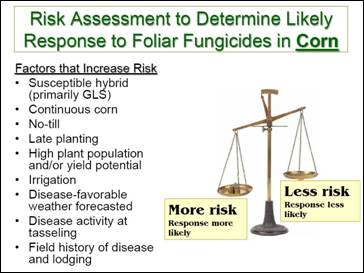
7. Late Corn Planting Usually Results in Faster Corn Development
Chad Lee, Grain Crops Extension
Plant and Soil Sciences, University of Kentucky
Corn planting in May will germinate, emerge, grow and develop in warmer temperatures compared to corn planted in April. Two critical stages of growth for early season management of corn are at growth stage V6 and V8. The growing point normally moves above ground on V6 corn (corn with six visible collars). If possible, N fertilizer should be applied by V8 (see related article in this newsletter). Many postemergence herbicide labels have applications restrictions for corn at either V6 or V8.
Based on data from the National Corn Handbook, corn should reach V6 in about 475 Growing Degree Days (GDD) and V8 in about 610 GDD. Using data from the University of Kentucky Ag Weather Center, over the last five years at Princeton, corn seeded on May 1 would have reached V6 and V8 about 9 and 12 days earlier, respectively, than corn seeded on April 1. Corn seeded on May 15 would have reached V6 and V8 about 13 and 16 days earlier, respectively, than corn seeded April 1.
As you plant corn late, and try to get soybeans planted as well, your postemergence herbicide applications and sidedressing of N fertilizer will need to occur earlier, relative to planting.
Figure 1. Calculated date and days to reach key Growing Degree Days (GDD) for Princeton, KY based on reported weather for 2004 - 2008. (source: UK Ag Weather Center, Calculators Page).
Seeding Date |
1-Apr |
1-May |
15-May |
Date to 475 GDDs |
6-May |
27-May |
6-Jun |
No. of Days from Seeding |
35 |
26 |
22 |
Date to 610 GDDs |
15-May |
2-Jun |
12-Jun |
No. of Days from Seeding |
44 |
32 |
28 |
8. Soybean Planting Delays
Jim Herbek and Chad Lee, Extension Agronomists
Plant and Soil Sciences, University of Kentucky
If corn planting continues to be delayed, this will have implications for a delay in soybean planting as well. However, as opposed to corn, soybean planting in Kentucky has a wider and later planting date window to achieve full yield potential. Planting date information for Kentucky indicates the optimum planting period is from early May to early June (June 7) before significant yield loss occurs (unless we have a summer drought as occurred in 2007 and 2008). There is a yield loss of 1.5 percent per day if soybean planting is delayed past early June.
For later planting dates of full season soybean, increase the target population to 120,000 plants per acre and go to row widths less than 30 inches. For a true double-crop system, final target populations should be closer to 140,000 to 160,000 plants per acre and narrow rows should be used as well.
9. Going Paperless
The Corn and Soybean Newsletter will likely go to an online only version by July of 2009. If you have been receiving the hard copy, please go online click on Sign Up for Newsletter and sign up for the electronic version. We apologize for any inconveniences that this may cause you.
In addition, we are starting a blog called "Grain Crops Update". The blog will contain some of this information as well. We are in the beta-test phase of the blog, so your comments and suggestions on improvement, content, etc. will be appreciated.
printer-friendly pdf (Note: this html site is also printer-friendly)

